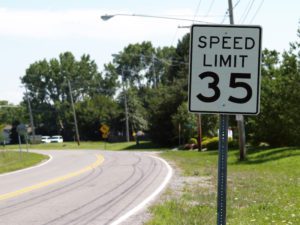Who is a member?
Our members are the local governments of Massachusetts and their elected and appointed leadership.

A new state law is intended to make the streets safer for road users other than vehicles.
On Jan. 2, Gov. Charlie Baker signed a law intended to improve safety for vulnerable road users — anyone other than a vehicle using a road — by clarifying key definitions, outlining vulnerable user passing requirements, requiring safety equipment on specific state vehicles, and clarifying a process for municipalities to reduce speed limits on roadways.
The law formally defines “vulnerable road users” as pedestrians, road workers, bicyclists, skateboarders, roller and in-line skaters, wheelchair users, non-motorized scooter users, users of electric assistive mobility devices, horses, horse drawn carriages, micro mobility devices, and operators of farm tractors and similar vehicles. The law grants the registrar of motor vehicles authority to add to this list, as needed, by regulation.
The law requires vehicles to pass vulnerable users at a safe passing distance of at least 4 feet, meaning they may cross the center line to provide this space, if needed and safe to do so. Further, the Massachusetts Department of Transportation will create and maintain signage informing drivers of these safe passage rules on public ways.
The law modifies the process for municipalities to amend speed limits or to restrict use by certain vehicles on municipal and state roads. Amendments to speed limits on municipal roads approved by local governing bodies will need certification from MassDOT’s Division of Highways that the change is in the public’s interest. Previously, such a change required certification from MassDOT and the registrar of motor vehicles.
The law also allows local governing bodies to petition MassDOT to adjust speed limits on state highways within a municipality. MassDOT must approve or respond to a petition within 90 days. If no response is provided, the new speed limit will become effective. MassDOT will be responsible for associated speed limit signage.
The law requires bicyclists to use rear red lights while riding at night, though a lack of such lights will not be cause for a stop by law enforcement. The requirement can only be enforced if a cyclist is stopped for another offense.
The law defines a number of vehicle safety devices and requires their use on state-owned and leased large trucks. Vehicles of Class 3 or above are required to be equipped with a lateral protective device, convex mirrors, cross-over mirrors, and backup cameras. The law prohibits after-market modifications that cause visual obstructions on such trucks.
As of Jan. 1, 2025, these safety requirements will extend to such vehicles that are operated under a contract with the state. MassDOT will initiate a study with the USDOT Volpe Transportation Systems Center on the affected large trucks, with the intent of producing safety recommendations related to direct vision afforded to drivers.
Within a year, MassDOT, in consultation with the Department of Public Health and the Executive Office of Public Safety and Security, will develop a standardized tool to report crashes and incidents involving vulnerable road users. Law enforcement or emergency medical services providers who respond to the incidents will be required to use the form. Data will be submitted to the registrar of motor vehicles and made available on a publicly accessible database.